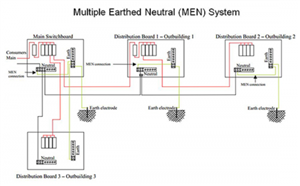Therefore each circuit can pass an insulation test, but the whole board can fail, so what do you do next?
AJJewsbury:
Therefore each circuit can pass an insulation test, but the whole board can fail, so what do you do next?
But there is no BS 7671 value for a single circuit to pass/fail - just one for the complete DB's worth - 1MΩ*
If the whole DB fails, then it's a fail.
- Andy.
* for initial verification at least.
AJJewsbury:
Regulation 643.2 says nothing about DBs
It's implied - given 314.4 you've got to have a DB between the distribution circuit and the final circuits (OK I could have been clearer that it includes the sub-main as well as the DB and final circuits).
- Andy.
mapj1:
Is an NE fault immedately dangerous, potentially dangerous, or just extremely annoying if it causes nuisance tripping ?
Personally, I think without another fault, such as an open CPC - which may come with the cable damage (rings are nice as you can test for that) or LN reversal, it is probably more of a pain than an immediate danger.

mapj1:
I think those are 'potential' dangers. Diverted neutral currents flow up every water and gas pipe in some streets, without injury, as the DNOs do not distinguish between N and E, and in other parts of the world an NE bond would be permitted and in some cases required by regulation .
mapj1:
I'm not saying an NE short is a good thing - far from it, but If all it does is lower R2 or trip an RCD prematurely above some modest level of load, then is only being a pain to the user, not the same 'immediate ' danger comparable to exposed live parts.
I don't think RCD tripping prematurely is the only outcome. RCD not tripping at all is another possibility (but perhaps not too common thankfully).
Only a really badly designed system becomes dangerous in a power cut and I'd hope they have back up power or some pre-arranged back-up supply.
And as noted above, when we started putting RCDs in, quite a lot of dormant N-E faults were found and had to be fixed, suggesting they had been around a while.
gkenyon:
Wombat:
What is the science behind the 1 MOhm minimum insulation resistance? What is the basis for this particular value?It matches perfectly the permitted touch current for double insulated appliances (0.5 mA) for a supply voltage U0 of 500 V.
For U0 = 1000 V, 1 MΩ would lead to a touch current of 1 mA (the accepted threshold of perception).
These values align with Clause 5.2.7 in BS EN 61140 Protection against electric shock - common aspects for installation and equipment, which states the limit of steady-state touch current to be 0.5 mA AC or 2 mA DC (higher levels are permitted in some circumstances).
In fact, there is some science behind these values, and they are based on the IEC 60479-series of standards Effect of current on human beings and livestock which is used as a reference standard for developing electrical safety standards - BS EN 61140 is itself based on this series of standards.
We're about to take you to the IET registration website. Don't worry though, you'll be sent straight back to the community after completing the registration.
Continue to the IET registration site